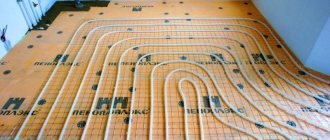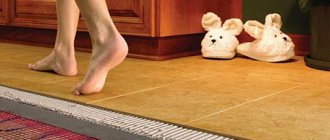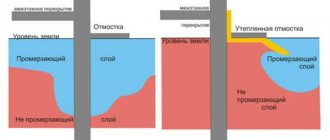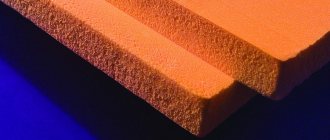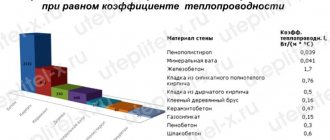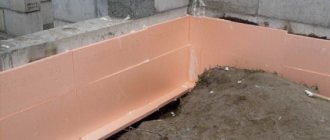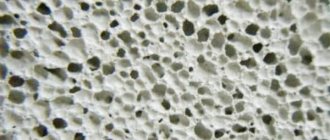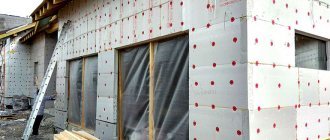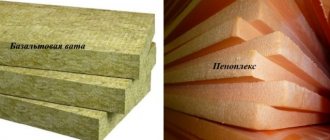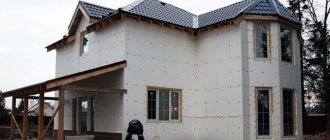The construction market is filled with many types of insulation materials. They come in rolls, slabs, backfill and sprayed. Since the assortment is very large, it can be difficult to make the right and informed choice. What can I say if there are more than 6 types of foam materials alone? We are talking about Ravaterm, Polyspen, Stirex, Penofol, Penoplex and Technoplex. The materials are used for internal and external insulation. Which material is better? To do this, you need to understand the features of each material, its advantages and disadvantages. Most experts recommend using Penoplex or Technoplex.
Why are they so good? Technoplex or Penoplex, which is better? What if you compare them with other materials? This is exactly what we will do.
Foamed polystyrene - what is it?
Penoplex is produced by the company of the same name. It creates insulating material using a special technology: extruded polystyrene is foamed under high pressure. The same applies to the technology for creating Technoplex, according to open sources. It is produced by TechnoNIKOL. As for the remaining details of the process of creating Penoplex and TechnoNIKOL insulation, nothing is reported about them. True, fragmentary data leads us to the following thoughts:
- Polystyrene granules, which act as the main raw material, are mixed with the gasifier. The mixture is heated to a high temperature and pressed through small holes. In this case, polystyrene granules must be highly purified.
- As the mixture passes through the micro-hole nozzle, the flow begins to break up into microscopic threads. In this case, the polymer molecules are pulled out and form a connection with each other. And thanks to pressure, they begin to harden.
- When the polypropylene comes out of the nozzle, it begins to foam and forms a porous material with thousands of small bubbles.
Important!
In the future, we will denote Penoplex as the first, and Technoplex as the second. It turns out that based on the technology of creation, it cannot be said that Penoplex or TechnoNIKOL is better. They are almost the same, the difference lies in composition and strength. According to the TechnoNIKOL company, the composition of their products, namely Technoplex, is enriched with amphora carbon or graphite. In this case, the rolling rollers can better form the material into its final shape and thickness.
So, Penoplex is made by extrusion. And Technoplex, thanks to the inclusion of graphite nanoparticles, increases the strength of the material, and its thermal conductivity coefficient decreases even more. Both the first and second materials are environmentally safe. They are safe and non-flammable. The materials will not dissolve in water or soil.
Note! There is a big difference between well-known and cheap manufacturers.
Conventional production technology involves the use of light freons mixed with carbon dioxide as a vapor-forming gas. As for new creation methods that are much better. For their implementation, liquid and powder gas-forming agents are used.
Comparison by main parameters
Mineral wool has a coefficient of 0.032-0.046, while penoplex has a coefficient of 0.03-0.032. The lower the indicator, the better, because there is less heat loss and the temperature inside the room is better maintained.
Duration of operation.
Penoplex is a fairly hard material that does not rot, dry out or crumble. The insulation has a long service life under the correct storage conditions, when it is reliably protected from prolonged sunlight and excessive heat. Mineral wool also does not dry out. Without exposure to high physical stress, it can last for a long time, is not afraid of high or low temperatures and long exposure to sunlight on the surface.
It is not at risk of mold and other harmful organisms, and it is also not susceptible to destruction by rodents. But mineral wool can crumble and settle on the wall. In general, both materials have an enormous service life, lasting at least 50 years.
Environmentally friendly.
Both materials are manufactured without the use of any hazardous components that could be harmful to human health, but still require absolute containment to protect the respiratory tract.
Comfortable installation.
When insulating a perfectly smooth surface, work using penoplex is carried out much faster. It is lightweight, easy to cut and sand, and with an L-shaped edge, it eliminates the formation of cold bridges. When using it, there is no need to cover it with a vapor barrier. If there is no tongue-and-groove edge, then it is tedious to seal the seams or lay them in two overlapping layers, which will lead to unnecessary costs.
Mineral wool has a little more weight, but it is much more efficient and simplifies installation in existing heavy, disproportionate areas and structures. But when working with it, you must purchase special clothing in advance, along with a respirator and safety glasses.
Which material is warmer?
If used to insulate the facade of a house, if the penoplex has a thickness of 50 mm, then the mineral wool should have a thickness of 60 mm to have a similar effect. The difference is not entirely dramatic. Depending on the situation, each of them is good in its own way, because cotton wool is capable of allowing air to pass through, unlike penoplex, which has an absolutely airtight structure.
Moisture absorption.
Mineral wool absorbs water much more strongly, subsequently losing some of its thermal insulation characteristics. In this case, penoplex is significantly better, because even with intense and frequent rains, its mass will practically not change.
Mineral wool has the best performance in this parameter, because it is almost inflammable. Its melting point should be more than 1000°. Cotton wool contains an adhesive base that can ignite, but it occupies a very tiny part of the total volume of the material and does not pose a significant danger.
Penoplex is completely opposite in its qualities. It can melt and burn in open fire, releasing toxins that are very harmful to the human body. To ensure a high level of protection of buildings from fire, penoplex is categorically unsuitable for use. For these purposes, the best and unconditional option is mineral wool.
Price.
The price of materials is practically no different. There may be a slight difference only depending on the choice of the manufacturer.
Comparison of Technoplex and Penoplex
In addition to the above, the materials contain antioxidants, stabilizers and anti-perenons that characterize the material. What is the difference between Penoplex and Technoplex? Let's compare the technical characteristics of the materials to answer this question:
- Area of use. Penoplex is used for external, internal, roofing and road thermal insulation. But Technoplex is used for internal insulation of residential buildings.
- Density of the material. For Penoplex it is 25–47 kg/m3. And Technoplex has a density of 26–35 kg/m3.
- The flammability group of Penoplex and Technoplex is the same - G4.
- Moisture absorption. Penoplex has a water absorption coefficient of 0.2–0.4%, and Technoplex 0.2%.
- The vapor permeability coefficient is almost the same, for Penoplex it is 0.012 mg/(mchPa), for Technoplex it is 0.010 mg/(mchPa).
- Cost - the first can be bought for 90–250 rubles/m2, and the second for 100–290 rubles/m2.
But that's not all that can be said about the materials. Let's compare some technical specifications.
Extrol or penoplex
Extrol is a polystyrene foam product obtained by extrusion. Physical indicators of density, thermal conductivity, vapor permeability, etc., are approximately the same as those of penoplex.
The products of this brand are produced not only in the form of slabs, but also in the form of special blocks, cylindrical and semi-cylindrical segments, which is very convenient for the production of thermal insulation of pipelines. There is no clear answer to the question of which material is better. Penoplex is more widely known, while Extrol’s products are not inferior to it in terms of physical parameters. Giving priority in this case should be justified by local price and product range.
Important! Resistance to aggressive environments. The resistance of polystyrene derivatives to chemicals is inferior to that of mineral wool.
Penoplex, technoplex and other similar materials disintegrate when exposed to: •solvents, acetone; •gasoline, kerosene and other refined products; •oil-based paints; •formaldehyde and its substances containing it; •coal tars.
This must be taken into account when handling the material and designing insulation.
Aspects to consider when choosing insulation:
— the thickness of the layer will be different, that is, the lower the thermal conductivity, the thinner the insulation layer is required; — the indicated physical parameters for polystyrene derivatives are correct for materials whose density is 35 kg/m3; for insulators with a different density, for example 30, 45 kg/m3, the values of the physical parameters will be different.
During installation work, it is necessary to determine the future location of the insulation. External insulation is considered correct, since the dew point will be in the outer layers of the main wall. If the insulation is installed from the inside and it is technically impossible to change this, then you need to take into account the possible appearance of moisture between the insulation slab and the wall of the building. To avoid this, you need to calculate ventilation and create control of air humidity in the room.
Penoplex can be replaced with similar polystyrene materials. The final result of insulation, as a rule, depends much more on the quality of the work performed, which implies the absence of cracks, leaks and the façade covering.
- Technical characteristics of penoplex
- Glue for penoplex and what to glue with?
- Penoplex plaster
- How and with what to attach penoplex to the wall?
- Do-it-yourself insulation of a balcony
Strength of insulation
It is easy to compare products by density if you use equipment for this. The mechanical compressive strength at a deformation of 10% of Penoplex type 35 is the same as that of Technoplex “XPS30-200 Standard”. As a result, the indicator for both one material and the other is 250 kPa.
As for the bending strength limit, Penoplex has an average value of 0.4 to 0.7 MPa. With strong bending, Technoplex has a strength limit of 0.3 MPa. It turns out that the first material has better resistance to bending, which is applied to it, and therefore is able to withstand heavy loads. It all comes down to the fact that the strength of insulation directly depends on its density. And with Penoplex it is higher.
Performance properties of extruded thermal insulation Penoplex
Extruded polystyrene foam panels are produced using special technology. The insulation compares favorably with polystyrene foam due to its perfect structure, increased strength, unique moisture and frost resistance and a long fifty-year service life.
Unlike the granular structure of polystyrene foam, the composition of extruded insulation is a homogeneous closed-cell structure that can withstand high compressive loads without consequences.
Naturally, the more complex and energy-intensive production of extruded material has resulted in an increase in its cost.
- A popular insulation material that makes it suitable for use in large-scale projects, it is in demand for thermal insulation of flat roofing structures and thin concrete screeds used in the installation of floor tiles.
- Extruded panels, which are focused on efficient and high-quality installation, are an excellent option for thermal insulation of foundations and blind areas, as well as underground structures for a wide variety of purposes.
Do you want to buy Penoplex at a dealer price with an official guarantee from the manufacturer? The time to do this is now!
Working temperature
Here the second insulation takes first place. Why can you say this? The optimal operating temperature range for the first is from -50 to +75°C. But the optimal operating temperature range for the second is from -70 to +75°C.
And if you believe the theory, then the choice falls on the second insulation. But it is obvious that even in the coldest region the air temperature does not reach -70 degrees. Therefore, this advantage cannot be called significant.
Common features
If you analyze the technical indicators of both insulation materials, you will notice that they do not have decisive differences:
- Temperature regime (considering the fact that in the CIS countries temperatures of -70°C rarely occur).
- These materials are heat-insulating and also environmentally friendly.
- In fact, they are not subject to dissolution in both water and soil.
- Used for individual construction and subsequent thermal insulation.
- They are destroyed when exposed to solvents and bitumen glue.
- Lightweight.
- They do not require special skills for installation work.
- Approximately the same price segment.
Heat conduction and moisture absorption
The thermal conductivity coefficient is one of the main parameters for insulation. The thermal conductivity parameter of the first is on average in the range from 0.028 to 0.031 W/mK, it all depends on the operating conditions. The second has an identical thermal conductivity parameter of 0.031 W/mK. It turns out that the effectiveness of materials in this area is the same.
The same applies to water absorption of materials. The first has an indicator of up to 0.2% of the volume per day, just like the second. This is truly surprising and shows that each of the materials copes well with moisture and resists it. Therefore, if anyone asks whether Penoplex or mineral wool is better, then we can confidently say that the first option. When wet, mineral wool loses its properties.
Note! The same applies to the frost resistance of the material. Its properties are not lost during frequent freezing and defrosting.
What is penoplex?
Penoplex is represented by extruded polystyrene foam cells, capable of providing a high level of thermal insulation of premises when the material is used as an element of building structures.
A notable property of the material in question is its resistance to water. Penoplex almost does not absorb moisture - and its use will be effective when it comes to structures in the basements of houses that may be exposed to water resulting from melting snow or due to water supply leaks.
Penoplex is used in the construction of balcony structures, to complement the foundations of houses, and placement between ceilings and attics.
The most important advantages of penoplex:
- simplicity and efficiency of laying elements made from the appropriate material;
- ease;
- ability for effective sound absorption;
- stability and long service life.
The structure of penoplex is represented by extremely small cells - this is its difference, for example, from polystyrene foam, in which the corresponding elements are noticeably larger. The manufacturing process of penoplex involves processing polystyrene at very high temperature and pressure. A special additive is added to the heated mass of raw materials, which gives the mixture a foaming effect. After that, extrusion is carried out.
Cost of products
Penoplex wins this confrontation. It is about 10% cheaper than its brother. At large volumes, this minor difference becomes quite significant. Therefore, in order to save money, it is better to choose the first option. The price in each region of Russia may be different, this should be taken into account.
With all this, we can conclude: each of the insulation materials is an excellent option. They are similar in their characteristics, but, nevertheless, Penoplex is a little better. It turns out that for a lower price you get high-quality insulation material. It is versatile and can be used for different purposes. Technoplex or Penoplex, which is better? Reviews say that each of the materials is good.
Features and Specifications
Penoplex thermal insulation is a board made of extruded polystyrene foam. A boutique materials company specializing in the production of synthetic insulation for a variety of roofing, foundation, wall and interior applications. For example, Penoplex 45 is supplied only to industrial sites and is used as thermal insulation for loaded structures, railways and roads, and airport runways.
The presented products in this series have reliable strength, resistance to biological influences, low thermal diffusivity and zero water absorption. Considering the manufacturer’s description, such insulation does not burn from environmentally friendly components without the addition of phenol-formaldehyde resins. This ensures a healthy indoor climate and a guaranteed service life of 50 years.
Radiator "Technoplex" produces a wide range of TechnoNIKOL products in the field of goods, including roofing, construction chemicals, special equipment and much more. Extruded insulation has proven itself mainly for interior work - insulation of partitions, balconies, floors. It is even used in installations of thermally insulated floor systems.
During the production of Technoplex, graphite nanoparticles are added to the same polystyrene foam, which, in turn, reduces thermal conductivity. Consequently, according to the manufacturer, the stability of Technoplex properties throughout its entire service life, reducing water absorption and vapor permeability. Neutral, biostable, practically non-shrinking polymer material takes care of gasoline solvents and bitumen adhesives. Well suited for use under plaster.
The difference between foamed polystyrenes
As mentioned above, the use of liquid and powder gas-forming agents is better, so products obtained using this technology have stable thermal insulation characteristics. Although, this cannot be called the only reason why Technoplex and Penoplex do not contain freon. There are two more:
- Sealed cells of new material that have not yet been used have remnants of freon. Formally, it is called safe, but in reality it is better not to deal with it. It can cause lung problems in children.
- Over time, the gas will be forced out of the cells by air and humidity. And if dirty raw materials containing styrene were used in the manufacture of the material, then the contents will penetrate into the external environment.
And if technical grades of EPS, such as Penofol, are used to treat foundations, highways, and plinths, then the presence of freon in the composition does not affect the material in any way. But to insulate your home, it is better to use safe products. Therefore, the answer to the question: Penoplex or Penofol, which is better, can be answered - the first option.
How do you know which is better Penoplex or expanded polystyrene? After all, many recommend insulating with foam plastic, because it has a low price and excellent characteristics. To answer this question, you need to know how penoplex differs from expanded polystyrene. Let's start with production technology.
Technoplex, Penoplex and even Penofol are created during the extrusion process. This allows you to obtain a very dense linear structure, which affects the material’s resistance to water and humidity, as well as strength. Therefore, foam plastic is somewhat worse than materials created by extrusion methods.
Both the wall and the floor rejoice at a large piece
In addition to hidden characteristics, externally assessed parameters also play an important role. These include, for example, linear dimensions. Due to the presence of several qualifications in this category, we will consider them separately.
The width of both insulation materials is not very diverse and is fixed at 580 and 600 mm for technoplex and penoplex, respectively.
Another indicator, the length, is a little pleasing, especially for the technoplex. If penoplex has a slab length of 1200 mm (2400 mm only for the slab of maximum density), then its opponent has 1180, 2380, 3000, 4000 and even 4500 mm. What a scope!
The range of slab thicknesses allows you to save money when combining a thermal insulation layer without resorting to laying a large amount of excess material. According to this parameter, penoplex shows results from 20 to 150 mm, with a more modest 20-120 mm for technoplex.
Comparing expanded polystyrene foam with other insulation materials
The main competitor for such materials are felt and fiber insulation. Some prefer to use mineral wool, others prefer Technoplex or Penoplex. Which is better, penoplex or mineral wool for insulation? Each of the materials has its own positive and negative properties. In the photo below you can see the features of expanded polystyrene foam.
Like mineral wool, they are durable, safe and environmentally friendly. True, the thermal insulation qualities and moisture absorption of mineral wool are worse.
Private one- and two-story premises are best treated with Penoplex. It is much more effective. Mineral wool is used for finishing high-rise buildings. The fact is that it does not burn at all. Fire retardant additives will not be able to protect EPPS 100%; mineral wool is better in this regard. However, it is not recommended to use it in damp and damp areas.
Another competitor for EPPS is isolon. This is insulation made from foamed and modified polyethylene. Some people ask, Izolon or Penoplex, which is better? Izolon is suitable for insulating internal walls and ceilings of a building. And the thermal conductivity coefficients of the materials are almost the same. Izolon can withstand heating up to 80 degrees Celsius throughout the day. The material has excellent sound and noise insulation. It is safe and environmentally friendly. When heated, it will not emit harmful substances. The main disadvantage is the softness and flexibility of Izolon. When laying it on the wall, it requires fixing with sheets of plasterboard or MDF boards. You cannot glue wallpaper or plaster on Izolon. This is why it is recommended to use it in conjunction with EPS insulation.
You can also find the following queries on the Internet: Ravaterm or Penoplex, which is better, Polyspen or Penoplex, which is better, or Stirex or Penoplex, which is better. It is impossible to answer the question unequivocally. All of them belong to XPS and have almost identical characteristics. The difference is the price and some additional nuances.
Safe for me, safe for you
It is impossible not to compare both materials in terms of their impact on the environment and interaction with it. Who to give preference: penoplex or technoplex?
The fire hazard of the materials is the same. They belong to the category of substances that support and spread combustion. When they burn, a gas that is unsuitable for breathing is released into the atmosphere. Because of this, they are not recommended for use as insulation without taking additional measures to ensure fire safety, for example, treating them with thermite.
The chemical and biological activity of these insulation materials is the same due to the use of the same source material: they are not afraid of contact with most building materials and solutions, are not attacked by insects and rodents, do not rot or spread fungus.
Environmental safety is ensured by the extremely stable position of the components. During the entire service life, there is no release of substances and compounds harmful to humans into the environment.
Both materials are destroyed under the influence of ultraviolet radiation, so their use without shelter is not recommended.
Internal wall insulation with technoplex
Similar work is carried out during the reconstruction of a home. It is also possible to insulate walls from the inside when the façade finishing has been completed recently. Preference should be given to technoplex sheets with a maximum thickness of 40 mm .
Since internal fastening is used in this case, the plates do not need to be fixed with dowels. Experts recommend leaving a small gap between the wall and the insulation itself. This will help reduce heat loss, but will lead to a reduction in living space. It is better to leave a distance, because this will provide natural ventilation. Accordingly, condensation will not penetrate inside, which means the humidity level in the room will remain optimal. This will help avoid rotting, and the walls of the house will dry out very quickly after rain.
When the insulation work using technoplex is completed, the wall surface must be finished . Wooden sheathing is often used for these purposes. It is also possible to use sheets of plasterboard, which are subsequently coated with paint or wallpaper.
Among the variety of modern insulation materials, special attention should be paid to technoplex. This material has excellent thermal insulation properties, thanks to which you can insulate your home both inside and outside. In this case, the help of professionals is not needed.
Dimensions, thickness and cost
The stability of thermal insulation parameters allows the use of slabs of medium thickness from 35 to 50 mm.
This is average for a typical solution in a temperate climate.
The increased thickness of penoplex up to 70 mm is most used in the northern regions, where the temperature often drops to 0 C. This approach is justified, especially since the average thickness of the remaining insulation reaches mm.
The dimensions of the slabs are standardized by the manufacturer to the usual mm in length and mm in width.
Compared to other types of insulation, the cost of penoplex is quite high: the cost of 1 square meter of sheet is on average $5. If modified with improved properties, including fire retardant additives, then the cost will be $ per 1 sq.m.
What to choose
If we compare these two insulation materials, then Technoplex is more technologically advanced and has better qualities, but the difference between it and Penoplex is so insignificant that it is impossible to say for sure which one should be chosen.
By choosing polystyrene foam insulation, regardless of whether it is Technoplex or Penoplex, you can get not only thermal insulation, but also sound and vapor barrier.
However, it is worth remembering that polystyrene foam is still a chemical insulation, not a natural one. Therefore, when burned, it releases very caustic substances.
Modern technologies do not stand still, and today liquid foam has become widespread. Details here: https://teplo.guru/uteplenie/utepliteli/zhidkiy-penoplast.html
Extruded polystyrene foam
Technoplex is a tile insulation made of extruded polystyrene foam with graphite particles. Thanks to graphite, the plates acquire a gray color and increased strength. 50 mm of technoplex is equivalent to a 600 mm wide foam block wall.
Technoplex is recommended for use for interior work. Produced by Technoplex.
Insulation is produced in the form of slabs of various widths, lengths and thicknesses:
- Length – 1180/1200 mm.
- Width – 580/600 mm.
- Thickness – 20, 30, 40, 50, 100 mm.
Technoplex is operated at temperatures from -70 0 C to +75 0 C. Its water absorption is only 0.2% - this is a very good indicator. Thermal conductivity is 0.032 W/(m*K).
Technical characteristics of Technoplex
High strength properties allow the material to be used where structures are subject to high loads. Being lightweight and thin, EPS boards nevertheless provide minimal heat loss compared to other analogues.
Important: Technoplex is chemically neutral (only gasoline and organic solvents are dangerous for it). The material is not susceptible to microorganisms, does not rot, and is not eaten by rodents. During operation, the insulation does not emit toxic substances.
The physical and technical parameters of Technoplex are given in the table.
Material advantages
To summarize, it should be noted that Technoplex is an improved modification of polystyrene foam. Here are the advantages of extrusion insulation.
- Strength. Gray EPS with graphite additives is 5-6 times stronger than expanded polystyrene. Polystyrene foam easily crumbles and breaks. It takes a lot of effort to break off a piece of extruded material.
- Density. Technoplex has a density and specific gravity that is 1.5-2 times higher. Therefore, it can withstand higher loads (it is not for nothing that it is used when forming a floor “pie”).
- Thermal insulation parameters. XPS retains heat better than foam products due to its smaller pores. With the same level of thermal protection, a Technoplex slab will be 25% thinner.
- Moisture resistance. Polystyrene foam absorbs water 5 times more actively: this is explained by its loose structure with numerous voids (although it should be noted that this figure is minimal). XPS with its minimal water absorption can remain in the ground for up to 50 years without losing its performance qualities.
The use of Technoplex is recommended wherever there are no increased requirements for vapor permeability. Installing the slabs of material is not difficult - the main thing is to fix them on the work surface and carefully foam the gaps.
Types, technical properties and purpose
Since this year, product differentiation has been introduced depending on the purpose and area of implementation. This allows you to quickly determine the appropriate type of insulation with a set of features for a certain type of work, facilitating very effective use.
Several types of extruded polystyrene are available:
WALL, or penoplex 31 with fire retardants
Designed for insulation of surfaces without dynamic or static load. It is optimal for insulating the walls of facades, partitions, swimming pools, wells, heating networks, and water supply systems.
Characteristics:
FOUNDATION, or penoplex 35 without fire retardant
The slabs are designed to withstand enormous overloads and vary in strength. Ideal for road surfaces, foundations, floors, and basement equipment.
The presence of a waterproof barrier allows groundwater to be drained from the underground part of the house.
Characteristics:
ROOFING, or penoplex 35
The slabs are designed to insulate roofs and attic spaces of any type, taking into account weather precipitation and temperature changes. Currently, it is used for flat roofs with winter gardens or parking lots placed on it (inversion roofing).
Characteristics:
COMFORT, or penoplex 31C
Universal slabs are suitable for insulating loggias, balconies, walls and floors of saunas, and mansions. It is characterized by increased water resistance and provides a better local climate.
Due to technical features, slabs of this type are especially tightly adjacent to each other.
Characteristics:
Penoplex 45
It is used for thermal protection of take-off surfaces and roads, protects against subsidence, deformation, and swelling of the canvas. Designed for enormous loads: can withstand the weight of an aircraft in regions with low temperatures.
The strongest retains its characteristics for a long time.
Characteristics:
Production technology and scope
The specifics of penoplex production are focused on improving the strength and technical characteristics.
It is given special characteristics by the process of extrusion from raw materials in special furnaces.
First, polystyrene granules are mixed with a foaming agent under conditions of high humidity and temperature. The catalyst is a composition of carbon dioxide (CO2) and freon. The polystyrene foam composition is melted in ovens and resembles fluffy cream.
Then, through the extrusion installation, the substance begins to be extruded, the freon evaporates evenly, and the cells are filled with normal air.
The use of penoplex in the construction industry has virtually no restrictions and, thanks to its technical features, can significantly reduce the costs of other consumables and energy resources.
Currently, a heat insulator is needed in various weather conditions for insulation and protection:
- foundations and walls of low-rise buildings;
- balconies and loggias;
- pools and wells;
- ceilings and basements;
- floors and ceilings;
- water supply systems;
- airfield runways;
- railways and roads;
Penoplex of various categories is widely used in the process of reconstruction of buildings due to its highest resistance to changes in the external environment and chemical influences.
Used for the production of sandwich panels.
What is a technoplex?
The basis for the manufacture of technoplex is the same polystyrene that has undergone extrusion processing. However, the production of the corresponding material is complemented by a remarkable production operation - the addition of tiny particles of graphite to the raw material. The result is a highly effective insulating material characterized by versatility, relatively low price and ease of installation.
Technoplex has generally the same advantages as penoplex. It is resistant to water, can effectively absorb sound, and has a long service life.
Extruded polystyrene foam
Penoplex is a tile insulation made from extruded polystyrene foam. Unique thermal insulation characteristics are achieved thanks to the smallest cells filled with air.
Penoplex has a bright and recognizable orange color. Penoplex has excellent chemical resistance, but it is important to know that it is absolutely not resistant to gasoline (just like Technoplex). Due to its good strength properties, Penoplex can be used for external insulation.
There are different types in the Penoplex line (their names speak for themselves):
- roofing (insulation of attics and roofs of various configurations);
- wall (basement, walls, partitions, facade are insulated);
- foundation (used as insulation for the basement and floor of the first floor);
- comfort (can be used for any work, but is especially well suited for insulating apartments and balconies);
- 45 (has the best characteristics of all types, used in road construction and bridge construction).
. Penoplex is available in standard width and length - 600 mm by 1200 mm, respectively. But the thickness varies - from 20 mm to 150 mm.
Penoplex is used at temperatures from -50 0 C to +75 0 C. Water absorption - 0.4% - slightly worse than Technoplex, but still a very high figure. Thermal conductivity is 0.03 W/(m*K).
